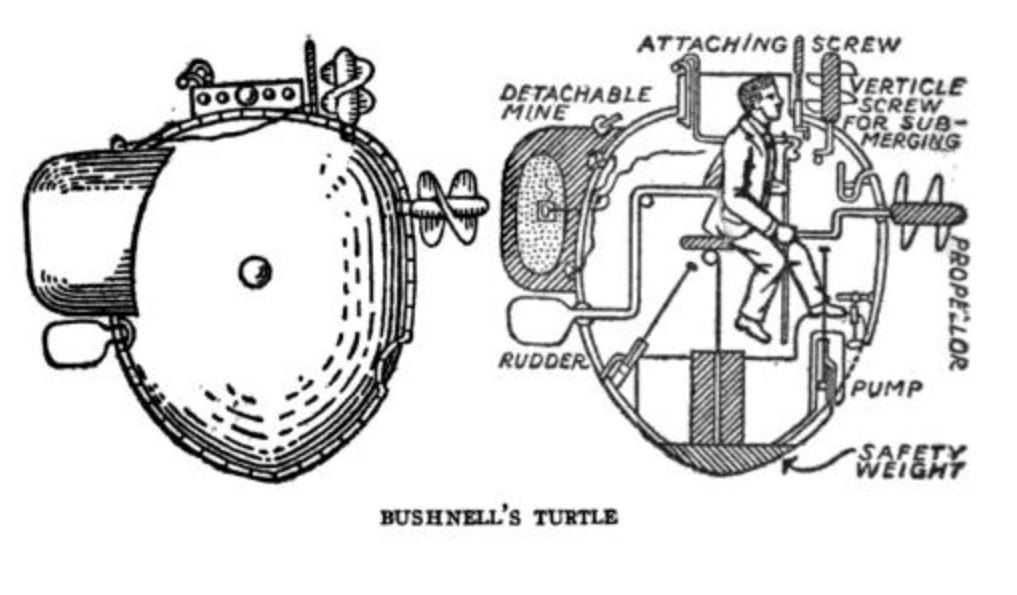TDIH: Submarines in the Revolution
The first submarine attack occurred during the American Revolution.
On this day in 1776, Americans launch the first submarine attack. They hoped to break a British blockade of New York harbor.
The submarine was the work of David Bushnell, an inventor from Connecticut. He called his submarine the “Turtle” because it was like “two upper tortoise shells of equal size, joined together.” The Turtle was the culmination of many years of work. Submarines were not entirely new, but Bushnell was still figuring out many underwater logistics for the first time. His submarine could hold one person and about 1/2 hour of air. Everything about it was very manual, with propellers, ballasts, and rudders being operated by hand cranks or foot pedals. The Turtle carried one underwater mine that could be attached to the underside of a ship. The submarine would then escape, leaving the mine to explode on a timed fuse.
Bushnell was unable to operate his own machine. He was not a very strong man, and he could not handle all the manual cranks and propellers. Instead, Bushnell originally planned for his brother, Ezra, to pilot the submarine. Unfortunately, Ezra fell ill at the last minute. Sergeant Ezra Lee (yes, another Ezra!) was recruited to replace him.
The mission? Navigate the Turtle to the British flag ship, the Eagle, which carried Admiral Richard Howe. Attach a mine and destroy the ship.
On the night of September 6/7, Lee embarked on his solitary mission. Can you imagine what must have been running through his head as he climbed into the Turtle, looking at its cramped space and many cranks and pedals?
Lee had to keep the Turtle close to the top of the water for as long as possible, partly so he could see and partly so he could get as much air as possible. He did not submerge until he was close enough to hear voices coming from the Eagle’s deck! Once underwater, he bounced along the bottom of the Eagle until he was certain that he’d reached the keel. He tried and tried to twist an auger into the ship above him. Suddenly, he was caught by a tide and pulled to the surface of the water.
Lee later said that he “immediately rode with great velocity, and came above the surface.” He went down again for another try, but then realized that he would not make it. Time was running out. He decided to retreat.
He took off across the harbor, staying underwater as much as possible, but occasionally surfacing for air. He was soon spotted. Lee realized that he needed to lighten the Turtle so he could make his getaway faster. He released the mine. About twenty minutes later, the mine exploded in the water. It would have worked perfectly, had it been attached to the Eagle.
The explosion was later described: “[It] threw into the air a prodigious column of water, resembling a great water-spout, attended with a report like thunder.”
The mission had failed, but Bushnell had proven that an underwater mine, with its timed fuse, could work.
Washington was appreciative of the effort and later wrote Thomas Jefferson: “I then thought, and still think, that it was an effort of genius.” Today, the Naval History and Heritage Command describes it as a “revolutionary development. . . . While a submarine ‘practical’ for warfare with range, power and reliability had to await the coming of the mechanical age, Turtle was an indispensable first step, which made future developments possible.”
American ingenuity! A defining feature of our republic as early as 1776.
Sources can always be found on my website, here.





The International Spy Museum in Washington DC has, to my surprise, a full size replica in its lobby.
I just find it amazing that such an invention could have been possible in 1776. Remarkable. It's too bad that Mr
Ezra Lee couldn't get the attachment drill to work.
Thank you Tara for another (repeat) history lesson.